Comprehensive Analysis of Toyota's Operations Management Strategies
VerifiedAdded on 2020/01/23
|21
|6044
|792
Report
AI Summary
This report provides a detailed analysis of Toyota's operations management, examining various aspects of its business strategies. The report begins with an overview of the importance of Toyota's operations management, followed by an analysis of its operational functions, including planning, designing, managing, and coordination. It then evaluates the process model used in Toyota's operations and the significance of economic efficiency, highlighting the 3E's (economy, efficiency, and effectiveness). The report explores cost and quality maximization strategies, including a PESTLE analysis, and evaluates operational performance objectives. Furthermore, it delves into linear programming, critical path analysis, and other theories to improve the production line, including justification for operational planning, capacity planning, and quality assurance. The report concludes with an examination of techniques for operational planning, aiming to provide a comprehensive understanding of Toyota's operational excellence.
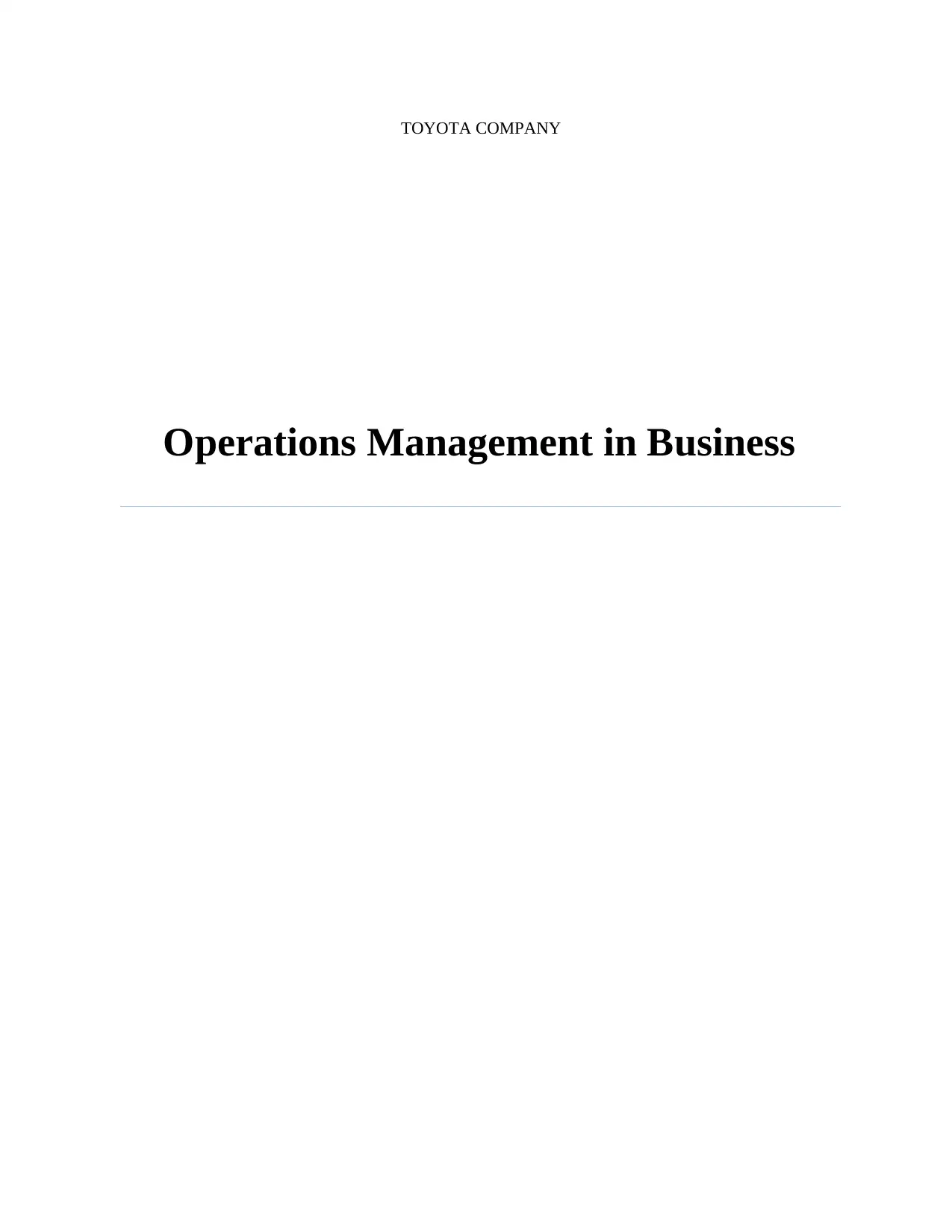
TOYOTA COMPANY
Operations Management in Business
Operations Management in Business
Paraphrase This Document
Need a fresh take? Get an instant paraphrase of this document with our AI Paraphraser

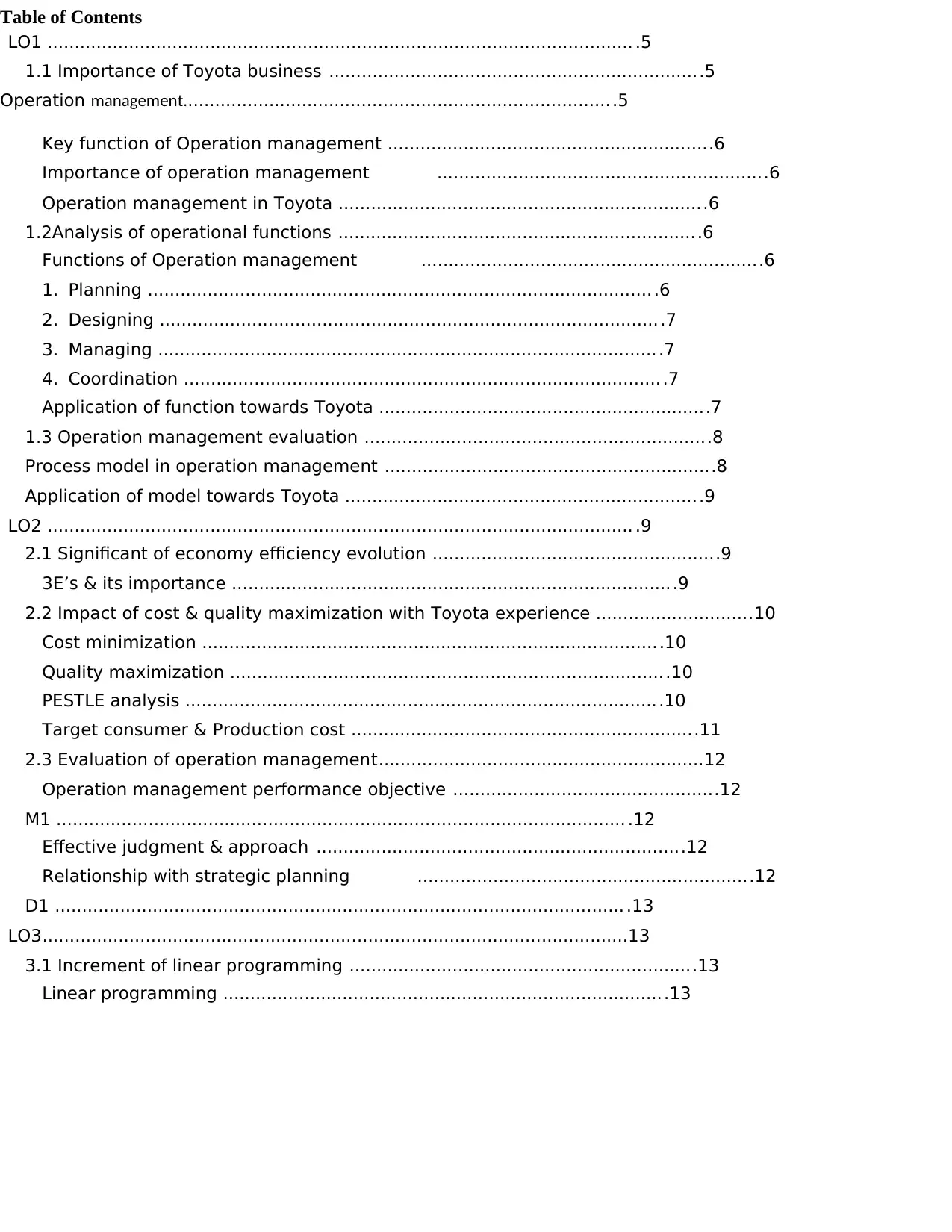
Table of Contents
LO1 ............................................................................................................ .5
1.1 Importance of Toyota business .....................................................................5
Operation management................................................................................5
Key function of Operation management ............................................................6
Importance of operation management .............................................................6
Operation management in Toyota ....................................................................6
1.2Analysis of operational functions ...................................................................6
Functions of Operation management ...............................................................6
1. Planning ............................................................................................. .6
2. Designing ............................................................................................ .7
3. Managing ............................................................................................ .7
4. Coordination ........................................................................................ .7
Application of function towards Toyota .............................................................7
1.3 Operation management evaluation ................................................................8
Process model in operation management .............................................................8
Application of model towards Toyota ..................................................................9
LO2 ............................................................................................................ .9
2.1 Significant of economy efficiency evolution .....................................................9
3E’s & its importance ..................................................................................9
2.2 Impact of cost & quality maximization with Toyota experience .............................10
Cost minimization .....................................................................................10
Quality maximization .................................................................................10
PESTLE analysis ....................................................................................... .10
Target consumer & Production cost ................................................................11
2.3 Evaluation of operation management............................................................12
Operation management performance objective .................................................12
M1 ......................................................................................................... .12
Effective judgment & approach ....................................................................12
Relationship with strategic planning ..............................................................12
D1 ......................................................................................................... .13
LO3............................................................................................................13
3.1 Increment of linear programming ................................................................13
Linear programming ..................................................................................13
LO1 ............................................................................................................ .5
1.1 Importance of Toyota business .....................................................................5
Operation management................................................................................5
Key function of Operation management ............................................................6
Importance of operation management .............................................................6
Operation management in Toyota ....................................................................6
1.2Analysis of operational functions ...................................................................6
Functions of Operation management ...............................................................6
1. Planning ............................................................................................. .6
2. Designing ............................................................................................ .7
3. Managing ............................................................................................ .7
4. Coordination ........................................................................................ .7
Application of function towards Toyota .............................................................7
1.3 Operation management evaluation ................................................................8
Process model in operation management .............................................................8
Application of model towards Toyota ..................................................................9
LO2 ............................................................................................................ .9
2.1 Significant of economy efficiency evolution .....................................................9
3E’s & its importance ..................................................................................9
2.2 Impact of cost & quality maximization with Toyota experience .............................10
Cost minimization .....................................................................................10
Quality maximization .................................................................................10
PESTLE analysis ....................................................................................... .10
Target consumer & Production cost ................................................................11
2.3 Evaluation of operation management............................................................12
Operation management performance objective .................................................12
M1 ......................................................................................................... .12
Effective judgment & approach ....................................................................12
Relationship with strategic planning ..............................................................12
D1 ......................................................................................................... .13
LO3............................................................................................................13
3.1 Increment of linear programming ................................................................13
Linear programming ..................................................................................13
⊘ This is a preview!⊘
Do you want full access?
Subscribe today to unlock all pages.

Trusted by 1+ million students worldwide
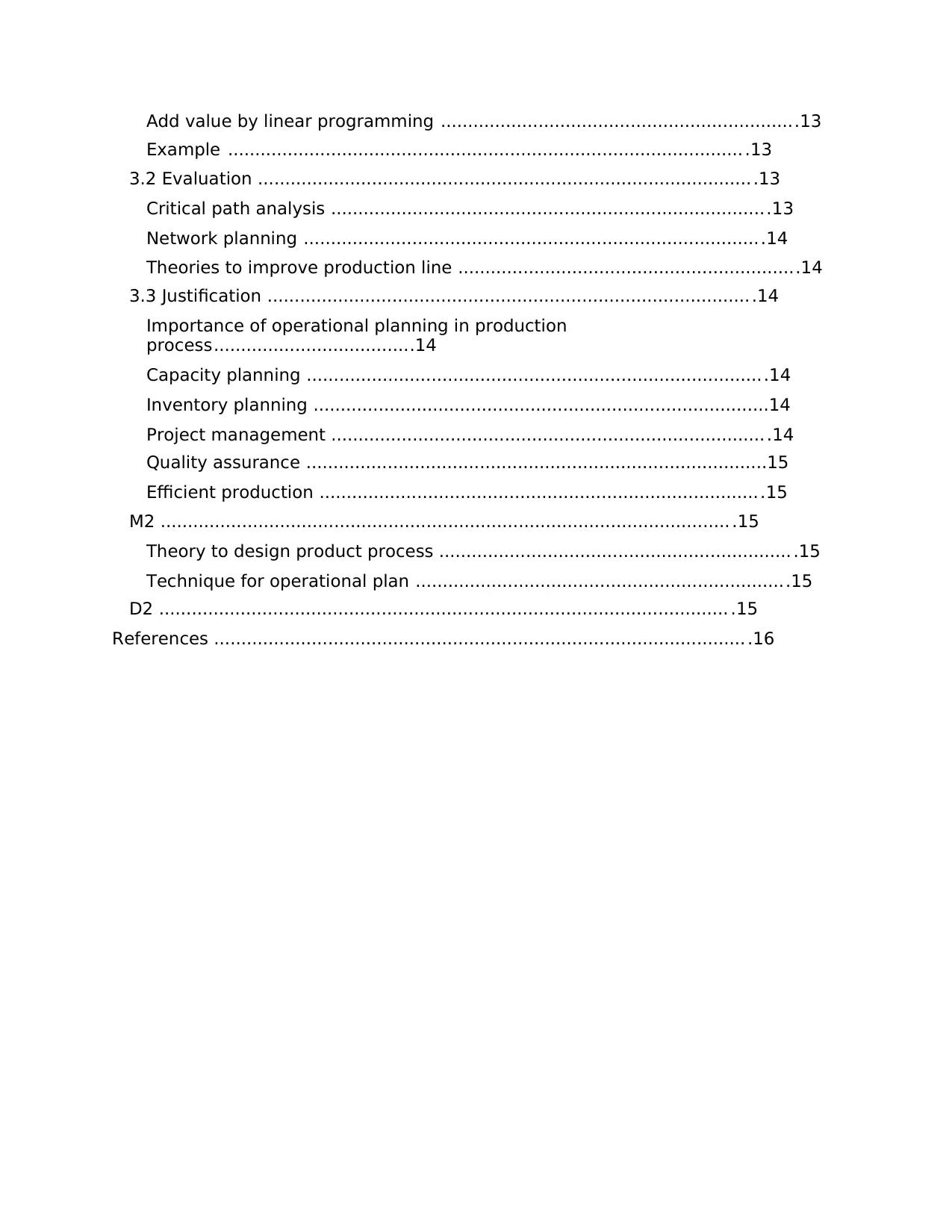
Add value by linear programming ..................................................................13
Example ............................................................................................... .13
3.2 Evaluation ........................................................................................... .13
Critical path analysis .................................................................................13
Network planning .....................................................................................14
Theories to improve production line ...............................................................14
3.3 Justification ......................................................................................... .14
Importance of operational planning in production
process.....................................14
Capacity planning .....................................................................................14
Inventory planning ....................................................................................14
Project management ................................................................................ .14
Quality assurance .....................................................................................15
Efficient production ..................................................................................15
M2 ......................................................................................................... .15
Theory to design product process ................................................................. .15
Technique for operational plan .....................................................................15
D2 ......................................................................................................... .15
References .................................................................................................. .16
Example ............................................................................................... .13
3.2 Evaluation ........................................................................................... .13
Critical path analysis .................................................................................13
Network planning .....................................................................................14
Theories to improve production line ...............................................................14
3.3 Justification ......................................................................................... .14
Importance of operational planning in production
process.....................................14
Capacity planning .....................................................................................14
Inventory planning ....................................................................................14
Project management ................................................................................ .14
Quality assurance .....................................................................................15
Efficient production ..................................................................................15
M2 ......................................................................................................... .15
Theory to design product process ................................................................. .15
Technique for operational plan .....................................................................15
D2 ......................................................................................................... .15
References .................................................................................................. .16
Paraphrase This Document
Need a fresh take? Get an instant paraphrase of this document with our AI Paraphraser
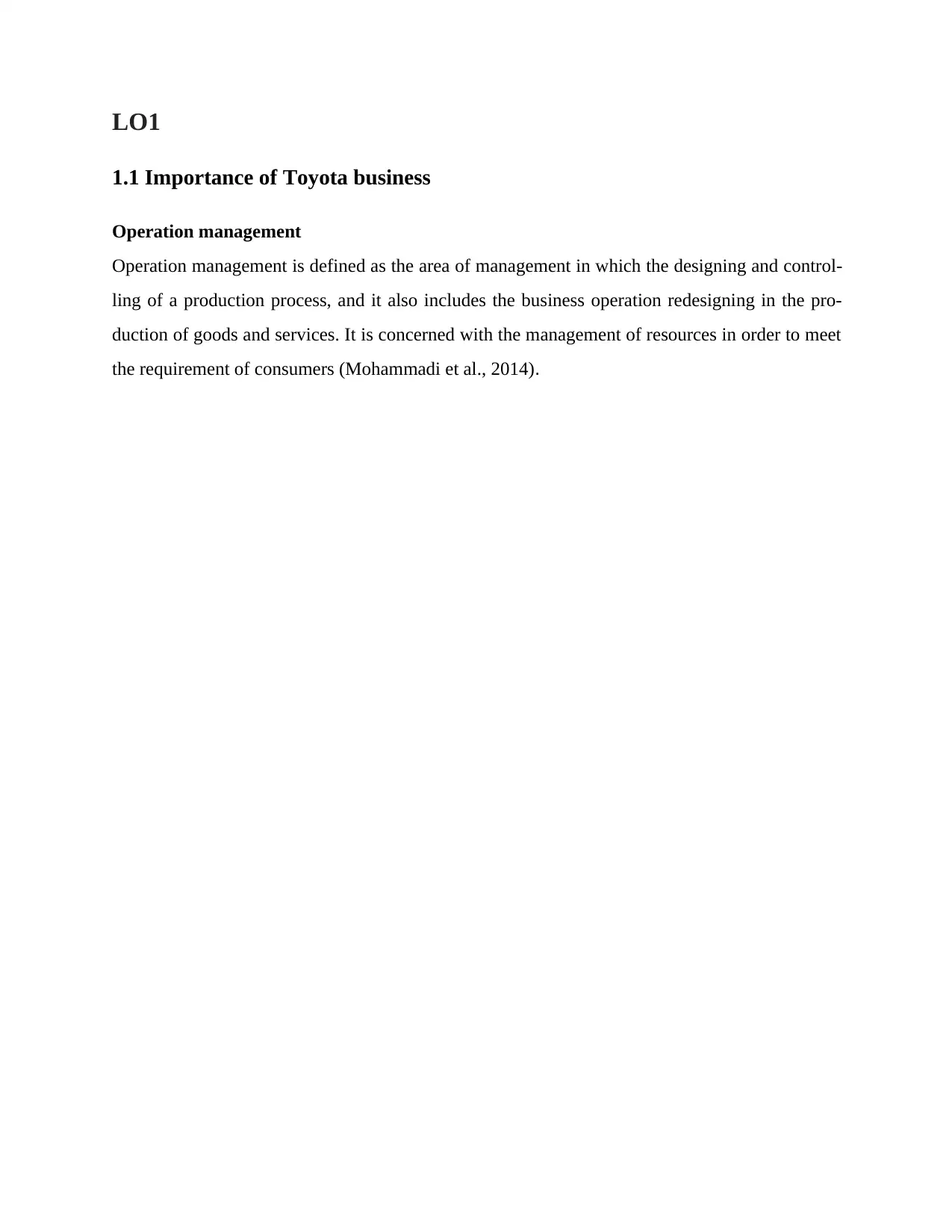
LO1
1.1 Importance of Toyota business
Operation management
Operation management is defined as the area of management in which the designing and control-
ling of a production process, and it also includes the business operation redesigning in the pro-
duction of goods and services. It is concerned with the management of resources in order to meet
the requirement of consumers (Mohammadi et al., 2014).
1.1 Importance of Toyota business
Operation management
Operation management is defined as the area of management in which the designing and control-
ling of a production process, and it also includes the business operation redesigning in the pro-
duction of goods and services. It is concerned with the management of resources in order to meet
the requirement of consumers (Mohammadi et al., 2014).
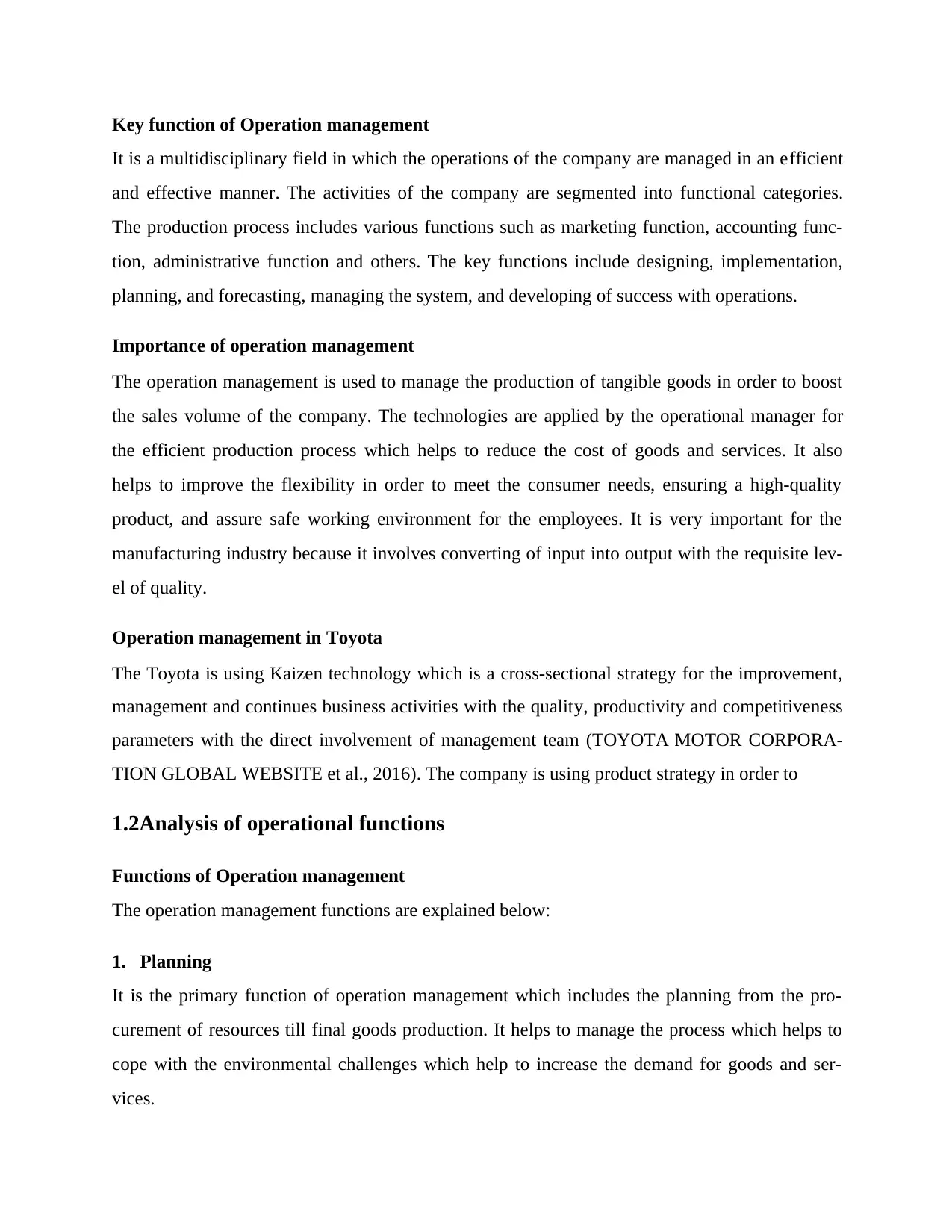
Key function of Operation management
It is a multidisciplinary field in which the operations of the company are managed in an efficient
and effective manner. The activities of the company are segmented into functional categories.
The production process includes various functions such as marketing function, accounting func-
tion, administrative function and others. The key functions include designing, implementation,
planning, and forecasting, managing the system, and developing of success with operations.
Importance of operation management
The operation management is used to manage the production of tangible goods in order to boost
the sales volume of the company. The technologies are applied by the operational manager for
the efficient production process which helps to reduce the cost of goods and services. It also
helps to improve the flexibility in order to meet the consumer needs, ensuring a high-quality
product, and assure safe working environment for the employees. It is very important for the
manufacturing industry because it involves converting of input into output with the requisite lev-
el of quality.
Operation management in Toyota
The Toyota is using Kaizen technology which is a cross-sectional strategy for the improvement,
management and continues business activities with the quality, productivity and competitiveness
parameters with the direct involvement of management team (TOYOTA MOTOR CORPORA-
TION GLOBAL WEBSITE et al., 2016). The company is using product strategy in order to
1.2Analysis of operational functions
Functions of Operation management
The operation management functions are explained below:
1. Planning
It is the primary function of operation management which includes the planning from the pro-
curement of resources till final goods production. It helps to manage the process which helps to
cope with the environmental challenges which help to increase the demand for goods and ser-
vices.
It is a multidisciplinary field in which the operations of the company are managed in an efficient
and effective manner. The activities of the company are segmented into functional categories.
The production process includes various functions such as marketing function, accounting func-
tion, administrative function and others. The key functions include designing, implementation,
planning, and forecasting, managing the system, and developing of success with operations.
Importance of operation management
The operation management is used to manage the production of tangible goods in order to boost
the sales volume of the company. The technologies are applied by the operational manager for
the efficient production process which helps to reduce the cost of goods and services. It also
helps to improve the flexibility in order to meet the consumer needs, ensuring a high-quality
product, and assure safe working environment for the employees. It is very important for the
manufacturing industry because it involves converting of input into output with the requisite lev-
el of quality.
Operation management in Toyota
The Toyota is using Kaizen technology which is a cross-sectional strategy for the improvement,
management and continues business activities with the quality, productivity and competitiveness
parameters with the direct involvement of management team (TOYOTA MOTOR CORPORA-
TION GLOBAL WEBSITE et al., 2016). The company is using product strategy in order to
1.2Analysis of operational functions
Functions of Operation management
The operation management functions are explained below:
1. Planning
It is the primary function of operation management which includes the planning from the pro-
curement of resources till final goods production. It helps to manage the process which helps to
cope with the environmental challenges which help to increase the demand for goods and ser-
vices.
⊘ This is a preview!⊘
Do you want full access?
Subscribe today to unlock all pages.

Trusted by 1+ million students worldwide

2. Designing
It starts with the product development then maintains the layout, use of machinery for production
purpose, then the development of system design information system which is the main function
to improve the performance of the production through monitoring and controlling.
3. Managing
It is the most crucial part of the success of operations. The team work is very necessary for man-
aging the operations. The systems are managed through employee encouragement which helps in
improving the performance of employees. It comprises of leadership, training and culture (Slack
et al., 2015).
4. Coordination
In this stage, the various part of the process is interrelated which helps to control the operations.
The roles and responsibilities are coordinated with the operational team. The two integrated re-
ports are developed, namely, vertical and horizontal report. The vertical report is reporting to the
manager, and horizontal report remains within the team members.
Application of function towards Toyota
The function towards Toyota is discussed below:
1. Planning
In this stage, the company has developed the global strategy which helps to develop which
helps to meet the demand of global customer locally. The company has developed kaizen
strategy for the improvement, management, and regular business activities. The product
strategy is based on the high quality with innovative technologies.
2. Designing
The company has developed the hybrid system as the basic manufacturing system and im-
proves its designing of engines by using alternative energy sources. The hybrid system is
It starts with the product development then maintains the layout, use of machinery for production
purpose, then the development of system design information system which is the main function
to improve the performance of the production through monitoring and controlling.
3. Managing
It is the most crucial part of the success of operations. The team work is very necessary for man-
aging the operations. The systems are managed through employee encouragement which helps in
improving the performance of employees. It comprises of leadership, training and culture (Slack
et al., 2015).
4. Coordination
In this stage, the various part of the process is interrelated which helps to control the operations.
The roles and responsibilities are coordinated with the operational team. The two integrated re-
ports are developed, namely, vertical and horizontal report. The vertical report is reporting to the
manager, and horizontal report remains within the team members.
Application of function towards Toyota
The function towards Toyota is discussed below:
1. Planning
In this stage, the company has developed the global strategy which helps to develop which
helps to meet the demand of global customer locally. The company has developed kaizen
strategy for the improvement, management, and regular business activities. The product
strategy is based on the high quality with innovative technologies.
2. Designing
The company has developed the hybrid system as the basic manufacturing system and im-
proves its designing of engines by using alternative energy sources. The hybrid system is
Paraphrase This Document
Need a fresh take? Get an instant paraphrase of this document with our AI Paraphraser
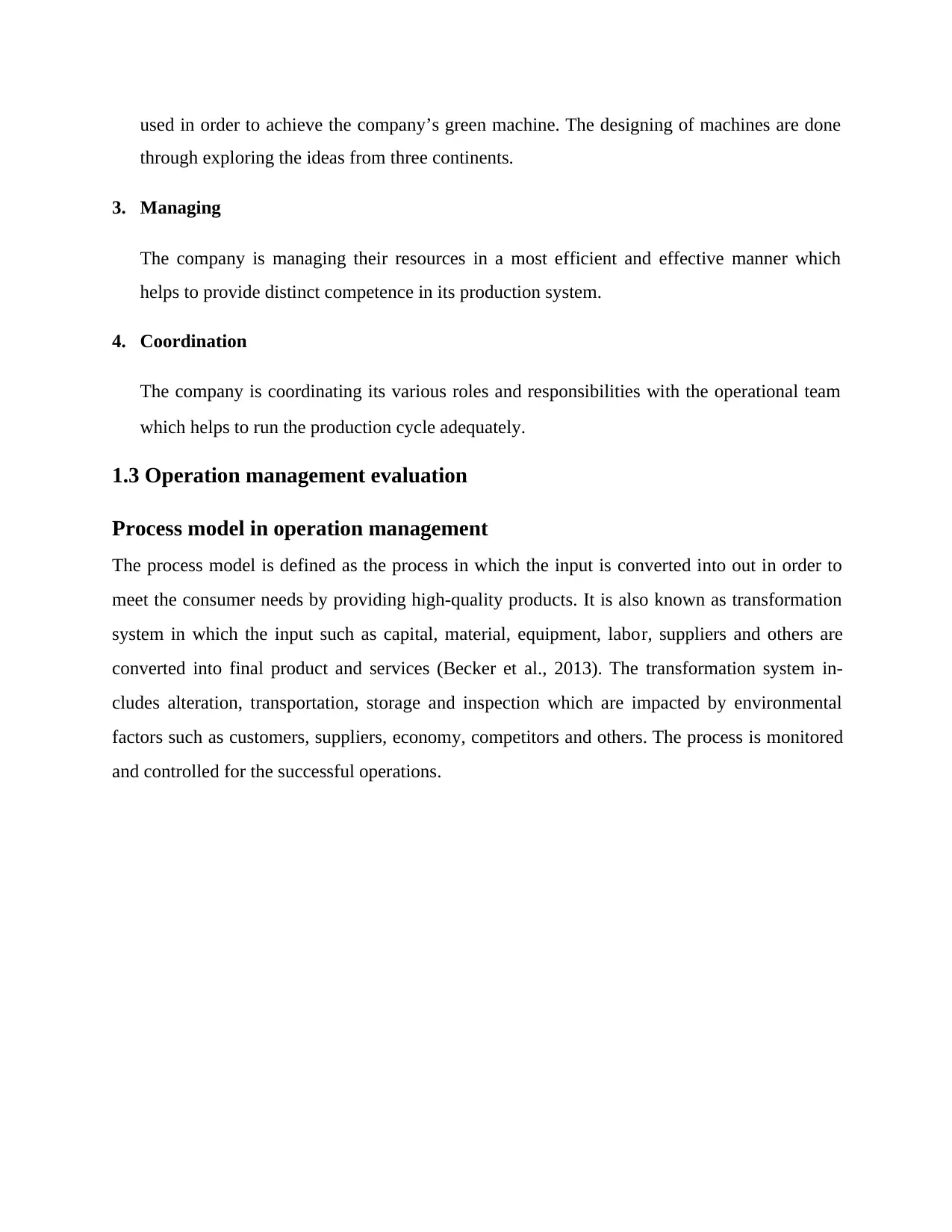
used in order to achieve the company’s green machine. The designing of machines are done
through exploring the ideas from three continents.
3. Managing
The company is managing their resources in a most efficient and effective manner which
helps to provide distinct competence in its production system.
4. Coordination
The company is coordinating its various roles and responsibilities with the operational team
which helps to run the production cycle adequately.
1.3 Operation management evaluation
Process model in operation management
The process model is defined as the process in which the input is converted into out in order to
meet the consumer needs by providing high-quality products. It is also known as transformation
system in which the input such as capital, material, equipment, labor, suppliers and others are
converted into final product and services (Becker et al., 2013). The transformation system in-
cludes alteration, transportation, storage and inspection which are impacted by environmental
factors such as customers, suppliers, economy, competitors and others. The process is monitored
and controlled for the successful operations.
through exploring the ideas from three continents.
3. Managing
The company is managing their resources in a most efficient and effective manner which
helps to provide distinct competence in its production system.
4. Coordination
The company is coordinating its various roles and responsibilities with the operational team
which helps to run the production cycle adequately.
1.3 Operation management evaluation
Process model in operation management
The process model is defined as the process in which the input is converted into out in order to
meet the consumer needs by providing high-quality products. It is also known as transformation
system in which the input such as capital, material, equipment, labor, suppliers and others are
converted into final product and services (Becker et al., 2013). The transformation system in-
cludes alteration, transportation, storage and inspection which are impacted by environmental
factors such as customers, suppliers, economy, competitors and others. The process is monitored
and controlled for the successful operations.

Application of model towards Toyota
The company considers a hybrid system as a basic factor of the eco-car technology. The input
products are taken with the research and development which helps to provide high-quality prod-
ucts to its international consumers through adapting local consumer’s demands. The company
has set up its design labs in Europe and the USA in order to understand the taste and preference
of consumers which helps to provide customized products with innovative technology. The com-
pany has better monitoring and controlling which helps to control various internal and external
factors. The company has invested in building production plants, design workshops, and research
centers which help to provide excellent products to its consumers.
LO2
2.1 Significant of economy efficiency evolution
3E’s & its importance
The acronyms of three E’s are, namely, economy, efficient and effective. These are the funda-
mentals which help to provide more flexibility and high pace in order to overcome the present
and future challenges. It helps to provide long-term benefits to the company by improving the
efficiencies of the company. The right balancing of 3E's helps to derive the high value to the or-
ganization (Shastri et al., 2013). The valuable organizations are followed by the economic gains.
The company considers a hybrid system as a basic factor of the eco-car technology. The input
products are taken with the research and development which helps to provide high-quality prod-
ucts to its international consumers through adapting local consumer’s demands. The company
has set up its design labs in Europe and the USA in order to understand the taste and preference
of consumers which helps to provide customized products with innovative technology. The com-
pany has better monitoring and controlling which helps to control various internal and external
factors. The company has invested in building production plants, design workshops, and research
centers which help to provide excellent products to its consumers.
LO2
2.1 Significant of economy efficiency evolution
3E’s & its importance
The acronyms of three E’s are, namely, economy, efficient and effective. These are the funda-
mentals which help to provide more flexibility and high pace in order to overcome the present
and future challenges. It helps to provide long-term benefits to the company by improving the
efficiencies of the company. The right balancing of 3E's helps to derive the high value to the or-
ganization (Shastri et al., 2013). The valuable organizations are followed by the economic gains.
⊘ This is a preview!⊘
Do you want full access?
Subscribe today to unlock all pages.

Trusted by 1+ million students worldwide
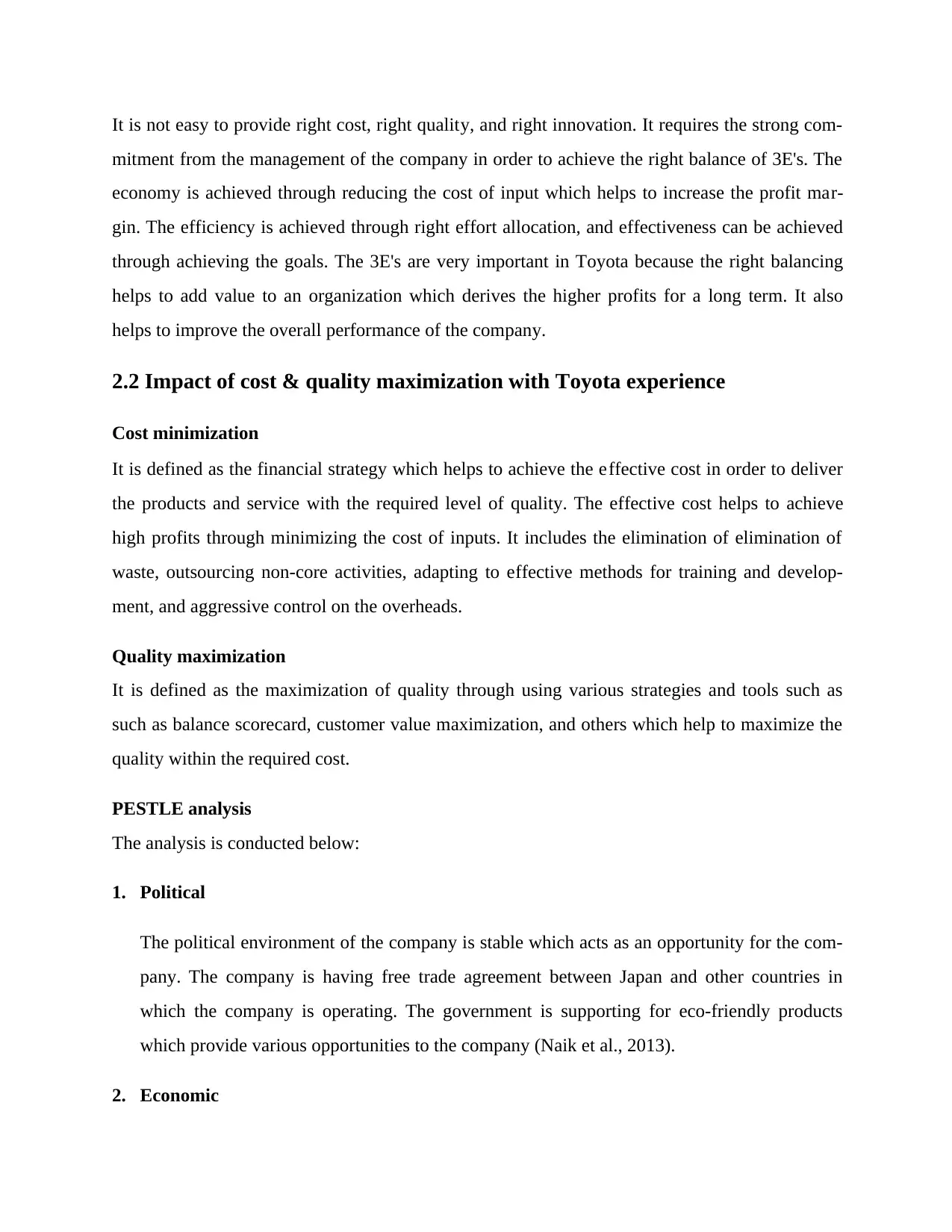
It is not easy to provide right cost, right quality, and right innovation. It requires the strong com-
mitment from the management of the company in order to achieve the right balance of 3E's. The
economy is achieved through reducing the cost of input which helps to increase the profit mar-
gin. The efficiency is achieved through right effort allocation, and effectiveness can be achieved
through achieving the goals. The 3E's are very important in Toyota because the right balancing
helps to add value to an organization which derives the higher profits for a long term. It also
helps to improve the overall performance of the company.
2.2 Impact of cost & quality maximization with Toyota experience
Cost minimization
It is defined as the financial strategy which helps to achieve the effective cost in order to deliver
the products and service with the required level of quality. The effective cost helps to achieve
high profits through minimizing the cost of inputs. It includes the elimination of elimination of
waste, outsourcing non-core activities, adapting to effective methods for training and develop-
ment, and aggressive control on the overheads.
Quality maximization
It is defined as the maximization of quality through using various strategies and tools such as
such as balance scorecard, customer value maximization, and others which help to maximize the
quality within the required cost.
PESTLE analysis
The analysis is conducted below:
1. Political
The political environment of the company is stable which acts as an opportunity for the com-
pany. The company is having free trade agreement between Japan and other countries in
which the company is operating. The government is supporting for eco-friendly products
which provide various opportunities to the company (Naik et al., 2013).
2. Economic
mitment from the management of the company in order to achieve the right balance of 3E's. The
economy is achieved through reducing the cost of input which helps to increase the profit mar-
gin. The efficiency is achieved through right effort allocation, and effectiveness can be achieved
through achieving the goals. The 3E's are very important in Toyota because the right balancing
helps to add value to an organization which derives the higher profits for a long term. It also
helps to improve the overall performance of the company.
2.2 Impact of cost & quality maximization with Toyota experience
Cost minimization
It is defined as the financial strategy which helps to achieve the effective cost in order to deliver
the products and service with the required level of quality. The effective cost helps to achieve
high profits through minimizing the cost of inputs. It includes the elimination of elimination of
waste, outsourcing non-core activities, adapting to effective methods for training and develop-
ment, and aggressive control on the overheads.
Quality maximization
It is defined as the maximization of quality through using various strategies and tools such as
such as balance scorecard, customer value maximization, and others which help to maximize the
quality within the required cost.
PESTLE analysis
The analysis is conducted below:
1. Political
The political environment of the company is stable which acts as an opportunity for the com-
pany. The company is having free trade agreement between Japan and other countries in
which the company is operating. The government is supporting for eco-friendly products
which provide various opportunities to the company (Naik et al., 2013).
2. Economic
Paraphrase This Document
Need a fresh take? Get an instant paraphrase of this document with our AI Paraphraser

The economic factors include strong U.S. dollar vs. weaker yen, U.S. economy vs. gradual
growth and high growth of developing countries which helps to opportunities to grow its
business.
3. Social
The trend of increasing interest of in hybrid cars and electric cars helps to grow a business
through increasing the demands of cars but also widen the wealth gap.
4. Technological
The company is using innovative technologies in producing the products which help to pro-
vide customized products to its consumers.
5. Legal
The company has adopted regulatory and legal laws of the country. The company has also
adopted the compensatory law, wages act, and others.
6. Environmental
The company is using eco-friendly products in order to protect the environment. The com-
pany is having sustainable performance through using effective business process.
Target consumer & Production cost
The company is targeting large market by buying differentiation and low-cost strategy in order to
gain the competitive advantage among the competitors within the same industry. The company is
targeting large market under which all type of automobile purchasers is covered. The company
provides various types of cars under all price ranges. The company provides four wheel trucks,
SUVs, hybrid models and others to in order to satisfy the need of consumers with the customized
products. The company has introduced hybrid cars in the market with the low-cost strategy
which helps to gain the large market share of the company.
growth and high growth of developing countries which helps to opportunities to grow its
business.
3. Social
The trend of increasing interest of in hybrid cars and electric cars helps to grow a business
through increasing the demands of cars but also widen the wealth gap.
4. Technological
The company is using innovative technologies in producing the products which help to pro-
vide customized products to its consumers.
5. Legal
The company has adopted regulatory and legal laws of the country. The company has also
adopted the compensatory law, wages act, and others.
6. Environmental
The company is using eco-friendly products in order to protect the environment. The com-
pany is having sustainable performance through using effective business process.
Target consumer & Production cost
The company is targeting large market by buying differentiation and low-cost strategy in order to
gain the competitive advantage among the competitors within the same industry. The company is
targeting large market under which all type of automobile purchasers is covered. The company
provides various types of cars under all price ranges. The company provides four wheel trucks,
SUVs, hybrid models and others to in order to satisfy the need of consumers with the customized
products. The company has introduced hybrid cars in the market with the low-cost strategy
which helps to gain the large market share of the company.

The company has achieved cost leadership strategy through using lean production, control of
suppliers, effective procurement of raw material, effective distribution and low cost of services
with the high quality of the product. The company is using low-cost strategy with the high quali-
ty of the product through innovative skills which helps to provide unique products to its con-
sumers.
2.3 Evaluation of operation management
Operation management performance objective
The impact of quality, dependability, flexibility, speed and cost helps to provide the high
quality of products with the short time period which enables to build brand image in the eyes of
the con- sumers and it directly impacts on the sales volume of the company. These objective
needs to be met by Toyota which helps to improve the performance of operations successfully
(Krajewski et al., 2013).
There is great impact of cost of reliability activities which is associated at the time when
Toyota organization make new products. It is not easy to set reliability cost at the time of
product development. Further operation management department need to ensure that it make
product of high quality so there customers not get dissatisfied. If flexibility is provided to
operation department then they can come up with new innovative ideas which lead to promptness
of an organization. Further if operation management make quality products and services then it
can easily make deliver high quality services to its customers. Further it give positive implication
on the performance of operation management department.
Quality: it is one of the main objective and it is important for Toyota company. Further the
external affect of the quality is that the consumer who buy product of Toyota company have less
change to complain.
Speed: Speed is important for an organization and it is a time between an external and internal
customer who request product and services for getting it. External speed is very important
because it lead to respond fastly to consumers.
Dependability: Dependability means on time. Toyata company deliver there products and
services on time. Further there are two type of independability internally and externally.
Internally dependability affects the cost of an organization.
Flexibility: all business operation are flexible so that is can deal with various product
requirement. Flexibility is needed so that company can make product and services at different
suppliers, effective procurement of raw material, effective distribution and low cost of services
with the high quality of the product. The company is using low-cost strategy with the high quali-
ty of the product through innovative skills which helps to provide unique products to its con-
sumers.
2.3 Evaluation of operation management
Operation management performance objective
The impact of quality, dependability, flexibility, speed and cost helps to provide the high
quality of products with the short time period which enables to build brand image in the eyes of
the con- sumers and it directly impacts on the sales volume of the company. These objective
needs to be met by Toyota which helps to improve the performance of operations successfully
(Krajewski et al., 2013).
There is great impact of cost of reliability activities which is associated at the time when
Toyota organization make new products. It is not easy to set reliability cost at the time of
product development. Further operation management department need to ensure that it make
product of high quality so there customers not get dissatisfied. If flexibility is provided to
operation department then they can come up with new innovative ideas which lead to promptness
of an organization. Further if operation management make quality products and services then it
can easily make deliver high quality services to its customers. Further it give positive implication
on the performance of operation management department.
Quality: it is one of the main objective and it is important for Toyota company. Further the
external affect of the quality is that the consumer who buy product of Toyota company have less
change to complain.
Speed: Speed is important for an organization and it is a time between an external and internal
customer who request product and services for getting it. External speed is very important
because it lead to respond fastly to consumers.
Dependability: Dependability means on time. Toyata company deliver there products and
services on time. Further there are two type of independability internally and externally.
Internally dependability affects the cost of an organization.
Flexibility: all business operation are flexible so that is can deal with various product
requirement. Flexibility is needed so that company can make product and services at different
⊘ This is a preview!⊘
Do you want full access?
Subscribe today to unlock all pages.

Trusted by 1+ million students worldwide
1 out of 21
Related Documents
Your All-in-One AI-Powered Toolkit for Academic Success.
+13062052269
info@desklib.com
Available 24*7 on WhatsApp / Email
![[object Object]](/_next/static/media/star-bottom.7253800d.svg)
Unlock your academic potential
Copyright © 2020–2025 A2Z Services. All Rights Reserved. Developed and managed by ZUCOL.





